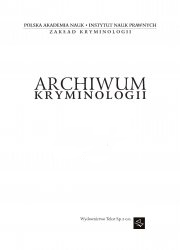Przestępczość i polityka karna w krajach postkomunistycznych: spojrzenie laika
Crime and Penal Policy in Post-Communist States: a Layman’s Perspective
Author(s): Andrzej SiemaszkoSubject(s): Law, Constitution, Jurisprudence
Published by: Instytut Nauk Prawnych PAN
Keywords: crime;penal policy;post-communist states;penal legislation;
Summary/Abstract: Can we seriously analyse penal policy trends in the post-communist states if we have no idea on the penal legislation in these countries, on trends in crime combat and prevention or the current shape of the penal policy, including in particular penal code reforms that are being developed or implemented? We would naturally say no. The author, however, attempts to prove that such an analysis is possible provided one has access to relevant statistical data. The data are contained mainly in three publications: European Sourcebook of Crime and Criminal Justice Statistics, Penological Information Bulletin and Atlas przestępczości w Polsce [Overview of Crime in Poland]. For the purposes of this paper, the data were significantly modified not to include some of the post-communist states. For various reasons, mainly due to the data credibility and completeness, the author focussed only on ten such states, i.e. Croatia, Czech Republic, Estonia, Lithuania, Latvia, Poland, Romania, Slovakia, Slovenia and Hungary. Some comparisons also include Bulgaria.Firstly, an analysis of the data shows that the common characteristics of the post-communist states under discussion are their high crime levels, both in terms of dynamics and prevalence. An exceptionally high level of crime risk is also displayed in the victimological research results. Secondly, a comparison of crime reporting levels clearly shows that the crime level in our region is actually much higher than police statistics might suggest. This is also confirmed by the results of nationwide Polish research held every four years within the International Crime Survey. We usually are one of the last countries in terms of crime reporting levels. It seems that people in our region are generally quite reluctant to report crime (due to our mistrust in police effectiveness), which makes our official crime statistics extremely unreliable. Therefore, while victimological research in the Western European countries may be treated as an interesting alternative to police statistics (and we actually could do without the latter), in our region, such research is a must. Thirdly, due to the extremely unreliable police statistics, it is essential to initiate victimological research in the countries of our region, and ideally to include them in the International Crime Survey. Without reliable victimological studies, we will have to rely on the police data that sometimes seem to be a tactless joke. The author's analysis, although not aimed at establishing any general rules, but rather at clearly describing the facts, naturally brings some obvious conclusions. The first conclusion is that all the former Soviet bloc countries were characterised by high crime levels at the turn of the 21st century. And the times are not conducive to softening penal repressions, which makes it obvious that most states under discussion continued their rather harsh penal policy compared to the Western countries. Poland was an interesting exception with its new and extremely liberal penal legislation having been introduced in the period of an extremely sharp crime growth. However, the author underlines that these developments had fortunately little influence on the judicial practice, all the more so since the main legislative and judicial changes to ease penal repressions had been introduced earlier. In other words, already before 1997 when the new penal codification was adopted, we had reached a dead end in crime policy liberalisation and there was no space left for more such changes for fear of mass protests and riots. The fact that the new and much more liberal penal code did not bring significant changes in the judicial practice proves the advantage of the judicial opinion over penal code solutions. This means and is clearly confirmed in the Polish experience that the form of penal legislation is much less important (though not unimportant) than specific judicial practice.All the states under analysis still show a disastrous structure of the length of unsuspended prison sentences. On the one hand, the shortest terms (up to one year, or even six months) are used too rarely, and on the other, too seldom are also the relatively long terms of ten and more years of prison. That makes sentence diversification seem insufficient. In all the states under discussion, the dominating group of imprisonment sentences are those from one to three years, which is inefficient from the criminology perspective, quite costly, and leads to the overpopulation of prisons. Therefore, it comes as no surprise that all these countries have such high imprisonment rates per 100,000 inhabitants.
Journal: Archiwum Kryminologii
- Issue Year: 2006
- Issue No: XXVIII
- Page Range: 67-94
- Page Count: 28
- Language: Polish

